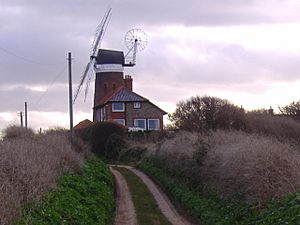Weybourne Windmill facts for kids
Quick facts for kids Weybourne Windmill |
|
|---|---|

Weybourne Windmill
|
|
| Origin | |
| Mill location | Village of Weybourne |
| Grid reference | TF76033267 |
| Coordinates | 52°56′37.3″N 1°08′50.0″E / 52.943694°N 1.147222°E |
| Information | |
| Purpose | 1850 |
Weybourne Windmill is a cool old building in the village of Weybourne, which is in Norfolk, England. You can find it on a hill overlooking the village, right next to the A149 coastal road. This road connects towns like King's Lynn and Great Yarmouth. The windmill is about 3 miles west of Sheringham and is part of a special protected area called the Norfolk Coast AONB. It's also a "Grade II listed building," which means it's an important historical structure that needs to be preserved.
Contents
About Weybourne Windmill
Weybourne Windmill was built in 1850. It has five floors and is made from red bricks. When it was working, its big sails helped to power three pairs of millstones. These millstones were used to grind grain into flour.
How the Mill Worked
The mill's sails are now fixed and point towards the east. In the past, these sails would turn to catch the wind. They powered the millstones, which were located on the second floor. The mill used to have four special sails, called "double shuttered sails."
The top part of the windmill, called the "cap," looks like a boat. It has an eight-bladed fan at the back. There used to be a walkway, or "stage," around the second floor, but it's not there anymore.
History of the Windmill
The windmill stopped grinding grain in 1916. After that, it started to fall apart. In 1925, some repairs were done, but most of the original machinery was taken out. Only a part called the "windshaft" was left.
By 1929, the windmill belonged to Sydney Broklesby. At this time, it didn't have its sails, the fantail (which helps turn the cap), or the walkway anymore.
Restoring the Windmill
In 1967, a person named Mr. Body bought the windmill. In 1968, a new cap was made and put on by a company called William Bird & Son. The skeleton sails you see today were put on in 1969 by Thompson & Son. Because there was no "brakewheel" (a part that helps control the sails), the sails were fixed to face east.
In 1970, the Norfolk Windmills Trust gave money to help paint the windmill. In 1973, they gave more money for extra repairs and upkeep. In 1982, the windmill was sold again for £125,000.

